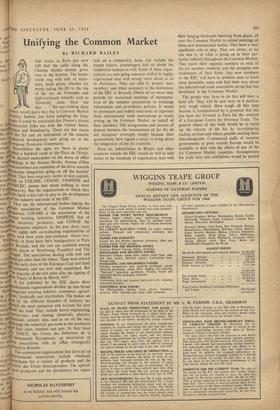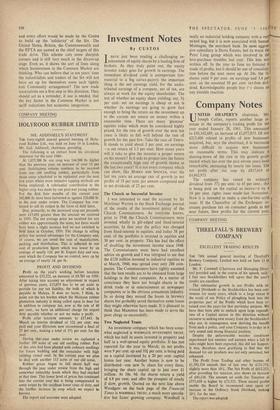Unifying the Common Market
By RICHARD BAILEY THE visitor to Paris just now will find the cafés along the Champs Elysecs already given over to the tourists. The boule- vards ring with talk of itiner- aries, hotel prices, whether it's worth taking the lift to the top of the Arc de Triomphe and half-overheard remarks such as `Givenchy must bless the
day. . . .' No one walking these streets would guess that this is Common Market country. Indeed, just from sampling the lang- uages it could be concluded that France's closest commercial links arc with the United States, Britain and Scandinavia. There are few traces °1 the Six and no indications of the massive industrial development now going on in the European Economic Community.
Nevertheless the signs are there in plenty Within a hundred yards of the Place dc
he discreet name-plates on the doors of office buildings in the Avenue Hoche, Avenue d'Idna and elsewhere are reminders of the drive towards economic integration going on off the tourists' beat. They bear enigmatic names in neat capitals, Inch as COLIME, COMAE, UNIPEDE and sent a ASSILEC, names that mean nothing to most livi passers-by. But the organisations to which they s rea refer have a key role to play in the development asisteta Of the
industry and trade of the EEC. rent They are the international bodies linking the out, as trade associations of the Common Market
Dry countries. COLIME is the association of the past.' metal working industries, UNIPEDE that of llethl theelectricity producers, and COM AF the ntric refrigeration engineers. In the past three years press ver eighty new co-ordinating organisations of yet I this kind have come into existence. About two- . WO thirds of them have their headquarters in Paris right' or Brussels, and the rest are scattered among origin Such places as Strasbourg, Frankfurt and The Hague, The associations dealing with coal and nove steel are older than the others. These were started :ales In the early days of the European Coal and Steel nee, Community and are now well established. But being he majority of the rest came after the signing of ,erica the Treaty of Rome in March, 1957. to Wel A list published by the EEC shows these man Professional organisations divided up into broad Honl categories covering industry, commerce, agricul- lg it i lure, foodstuffs and distribution. The bodies set lved a ,143 by the different btanches of industry are cad half the most numerous and account for over nethi nalf the total. They include heavy engineering, uroelnotor-cars, coal mining, chemicals, pharma- d her ceUticals, ceramic tiles, and so on all the way War through the industrial spectrum to the producers s of hi 91 fruit juice, mustard and jam. At their head „ UNICE, the Union des Industries de la are al "rnmunaute Europ6cnne, an association of sty an 1°P associations with its office strategically [lace 'laced in Brussels.
. The commercial organisations that have set up a e`) International associations include wholesale ated t merchants for a variety of products and the nd union des Foires Internationales. The agricul- 'Pecteg Ural producers and the distributors are organ- DeVOtt-
ised on a commodity basis and include the master bakers, ironmongers and no doubt the candlestick-makers as well. Some of these organ- isations are now going concerns staffed by highly experienced men with strong views about In ioi de Parkinson. They are able to present their members' case when necessary to the institutions of the EEC in Brussels. Others do no more than provide for occasional meetings of representa- tives of the member associations to exchange information and co-ordinate policies. It would be premature and indeed inaccurate to represent these international trade associations as busily sewing up the Common Market on behalf of their members. Old antagonisms and sources of distrust between the businessmen of the Six do not disappear overnight simply because their governments have signed a treaty to bring about the integration of the six countries.
Even so, industrialists in Britain and other countries outside the EEC would do well to take notice of the hundreds of organisation men with their bulging briefcases hurrying from places all over the Common Market to attend meetings of these new international bodies. They have a very significant role to play. They are aware, as no one else is, of what is going on in their par- ticular industry throughout the Common Market. They know their opposite numbers in each of the six member countries and the strengths and weaknesses of their firms. Any new members of the EEC will have to produce men to learn these particular ropes and find their way about the international trade association set-up that has developed in the Common Market.
The people who have to do this will have a hard job. They will be new boys in a particu- larly tough school. How tough all this may become is foreshadowed by a proposal that has just been put forward in Paris for the creation of a European Centre for Overseas Trade. The general object of this body would be to build up the exports of the Six by co-ordinating trading services and where possible making them interchangeable. Commercial staffs of member governments at posts outside Europe would be available to deal with the affairs of any of the six Common Market countries. Arrangements for trade fairs and exhibitions would be pooled
and every effort would be made by the Centre to build up the 'solidarity' of the Six. The United States, Britain, the Commonwealth and the EFTA are named as the chief targets of this trade drive. This scheme cuts some sharpish corners and is still very much in the dream-up stage. Even so, it shows the sort of lines along which businessmen in the Common Market are thinking. Who can believe that in ten years' time the industrialists and traders of the Six will not have set up for themselves some such tightly knit Community arrangement? The new trade associations are a first step in this direction. They should act as a reminder, if one is needed, that the key factor in the Common Market is not tariff reductions but economic integration.



































 Previous page
Previous page